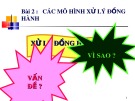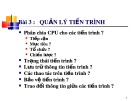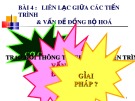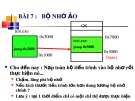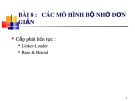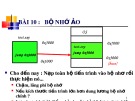Chapter 17: Distributed-File Systems
Silberschatz, Galvin and Gagne ©2009 Silberschatz, Galvin and Gagne ©2009 Operating System Concepts – 8th Edition, 17.1 Operating System Concepts – 8th Edition
Chapter 17 Distributed-File Systems
n Background n Naming and Transparency n Remote File Access n Stateful versus Stateless Service n File Replication n An Example: AFS
Silberschatz, Galvin and Gagne ©2009 17.2 Operating System Concepts – 8th Edition
Chapter Objectives
n To explain the naming mechanism that provides location transparency
and independence
n To describe the various methods for accessing distributed files
n To contrast stateful and stateless distributed file servers
n To show how replication of files on different machines in a distributed
file system is a useful redundancy for improving availability
n To introduce the Andrew file system (AFS) as an example of a
distributed file system
Silberschatz, Galvin and Gagne ©2009 17.3 Operating System Concepts – 8th Edition
Background
n Distributed file system (DFS) – a distributed implementation of the classical time-sharing model of a file system, where multiple users share files and storage resources
n A DFS manages set of dispersed storage devices
n Overall storage space managed by a DFS is composed of different,
remotely located, smaller storage spaces
n There is usually a correspondence between constituent storage
spaces and sets of files
Silberschatz, Galvin and Gagne ©2009 17.4 Operating System Concepts – 8th Edition
DFS Structure
n Service – software entity running on one or more machines and providing a particular type of function to a priori unknown clients
n Server – service software running on a single machine
n Client – process that can invoke a service using a set of operations
that forms its client interface
n A client interface for a file service is formed by a set of primitive file
operations (create, delete, read, write)
n Client interface of a DFS should be transparent, i.e., not distinguish
between local and remote files
Silberschatz, Galvin and Gagne ©2009 17.5 Operating System Concepts – 8th Edition
Naming and Transparency
n Naming – mapping between logical and physical objects
n Multilevel mapping – abstraction of a file that hides the details of how
and where on the disk the file is actually stored
n A transparent DFS hides the location where in the network the file is
stored
n For a file being replicated in several sites, the mapping returns a set of the locations of this file’s replicas; both the existence of multiple copies and their location are hidden
Silberschatz, Galvin and Gagne ©2009 17.6 Operating System Concepts – 8th Edition
Naming Structures
n Location transparency – file name does not reveal the file’s physical
storage location
n Location independence – file name does not need to be changed
when the file’s physical storage location changes
Silberschatz, Galvin and Gagne ©2009 17.7 Operating System Concepts – 8th Edition
Naming Schemes — Three Main Approaches
n Files named by combination of their host name and local name;
guarantees a unique system-wide name
n Attach remote directories to local directories, giving the appearance of a coherent directory tree; only previously mounted remote directories can be accessed transparently
n Total integration of the component file systems
l A single global name structure spans all the files in the system l If a server is unavailable, some arbitrary set of directories on
different machines also becomes unavailable
Silberschatz, Galvin and Gagne ©2009 17.8 Operating System Concepts – 8th Edition
Remote File Access
n Remote-service mechanism is one transfer approach
n Reduce network traffic by retaining recently accessed disk blocks in a cache, so that repeated accesses to the same information can be handled locally l If needed data not already cached, a copy of data is brought from
the server to the user
l Accesses are performed on the cached copy l Files identified with one master copy residing at the server
machine, but copies of (parts of) the file are scattered in different caches
l Cache-consistency problem – keeping the cached copies
consistent with the master file
4 Could be called network virtual memory
Silberschatz, Galvin and Gagne ©2009 17.9 Operating System Concepts – 8th Edition
Cache Location – Disk vs. Main Memory
n Advantages of disk caches
l More reliable l Cached data kept on disk are still there during recovery and
don’t need to be fetched again
n Advantages of main-memory caches: l Permit workstations to be diskless l Data can be accessed more quickly l Performance speedup in bigger memories l Server caches (used to speed up disk I/O) are in main memory
regardless of where user caches are located; using main- memory caches on the user machine permits a single caching mechanism for servers and users
Silberschatz, Galvin and Gagne ©2009 17.10 Operating System Concepts – 8th Edition
Cache Update Policy
n Write-through – write data through to disk as soon as they are placed
on any cache l Reliable, but poor performance
n Delayed-write – modifications written to the cache and then written
through to the server later l Write accesses complete quickly; some data may be overwritten before they are written back, and so need never be written at all l Poor reliability; unwritten data will be lost whenever a user machine
crashes
l Variation – scan cache at regular intervals and flush blocks that
have been modified since the last scan
l Variation – write-on-close, writes data back to the server when the
file is closed
4 Best for files that are open for long periods and frequently
modified
Silberschatz, Galvin and Gagne ©2009 17.11 Operating System Concepts – 8th Edition
CacheFS and its Use of Caching
Silberschatz, Galvin and Gagne ©2009 17.12 Operating System Concepts – 8th Edition
Consistency
n Is locally cached copy of the data consistent with the master copy?
n Client-initiated approach
l Client initiates a validity check l Server checks whether the local data are consistent with the
master copy
n Server-initiated approach
l Server records, for each client, the (parts of) files it caches l When server detects a potential inconsistency, it must react
Silberschatz, Galvin and Gagne ©2009 17.13 Operating System Concepts – 8th Edition
Comparing Caching and Remote Service
n In caching, many remote accesses handled efficiently by the local cache; most remote accesses will be served as fast as local ones
n Servers are contracted only occasionally in caching (rather than for
each access) l Reduces server load and network traffic l Enhances potential for scalability
n Remote server method handles every remote access across the network; penalty in network traffic, server load, and performance
n Total network overhead in transmitting big chunks of data (caching) is lower than a series of responses to specific requests (remote-service)
Silberschatz, Galvin and Gagne ©2009 17.14 Operating System Concepts – 8th Edition
Caching and Remote Service (Cont.)
n Caching is superior in access patterns with infrequent writes
l With frequent writes, substantial overhead incurred to overcome
cache-consistency problem
n Benefit from caching when execution carried out on machines with
either local disks or large main memories
n Remote access on diskless, small-memory-capacity machines should
be done through remote-service method
n In caching, the lower intermachine interface is different form the upper
user interface
n In remote-service, the intermachine interface mirrors the local user-file-
system interface
Silberschatz, Galvin and Gagne ©2009 17.15 Operating System Concepts – 8th Edition
Stateful File Service
n Mechanism
l Client opens a file l Server fetches information about the file from its disk, stores it in its memory, and gives the client a connection identifier unique to the client and the open file
l Identifier is used for subsequent accesses until the session ends l Server must reclaim the main-memory space used by clients who
are no longer active
n Increased performance
l Fewer disk accesses l Stateful server knows if a file was opened for sequential access and
can thus read ahead the next blocks
Silberschatz, Galvin and Gagne ©2009 17.16 Operating System Concepts – 8th Edition
Stateless File Server
n Avoids state information by making each request self-contained
n Each request identifies the file and position in the file
n No need to establish and terminate a connection by open and close
operations
Silberschatz, Galvin and Gagne ©2009 17.17 Operating System Concepts – 8th Edition
Distinctions Between Stateful and Stateless Service
n Failure Recovery
l A stateful server loses all its volatile state in a crash
4 Restore state by recovery protocol based on a dialog with clients, or abort operations that were underway when the crash occurred
4 Server needs to be aware of client failures in order to reclaim
space allocated to record the state of crashed client processes (orphan detection and elimination)
l With stateless server, the effects of server failure sand recovery are
almost unnoticeable
4 A newly reincarnated server can respond to a self-contained
request without any difficulty
Silberschatz, Galvin and Gagne ©2009 17.18 Operating System Concepts – 8th Edition
Distinctions (Cont.)
n Penalties for using the robust stateless service:
l longer request messages l slower request processing l additional constraints imposed on DFS design
n Some environments require stateful service
l A server employing server-initiated cache validation cannot provide stateless service, since it maintains a record of which files are cached by which clients
l UNIX use of file descriptors and implicit offsets is inherently
stateful; servers must maintain tables to map the file descriptors to inodes, and store the current offset within a file
Silberschatz, Galvin and Gagne ©2009 17.19 Operating System Concepts – 8th Edition
File Replication
n Replicas of the same file reside on failure-independent machines
n Improves availability and can shorten service time
n Naming scheme maps a replicated file name to a particular replica l Existence of replicas should be invisible to higher levels l Replicas must be distinguished from one another by different
lower-level names
n Updates – replicas of a file denote the same logical entity, and thus an
update to any replica must be reflected on all other replicas
n Demand replication – reading a nonlocal replica causes it to be cached
locally, thereby generating a new nonprimary replica
Silberschatz, Galvin and Gagne ©2009 17.20 Operating System Concepts – 8th Edition
An Example: AFS
n A distributed computing environment (Andrew) under development since 1983 at Carnegie-Mellon University, purchased by IBM and released as Transarc DFS, now open sourced as OpenAFS
n AFS tries to solve complex issues such as uniform name space, location-independent file sharing, client-side caching (with cache consistency), secure authentication (via Kerberos) l Also includes server-side caching (via replicas), high availability l Can span 5,000 workstations
Silberschatz, Galvin and Gagne ©2009 17.21 Operating System Concepts – 8th Edition
ANDREW (Cont.)
n Clients are presented with a partitioned space of file names: a local
name space and a shared name space
n Dedicated servers, called Vice, present the shared name space to the clients as an homogeneous, identical, and location transparent file hierarchy
n The local name space is the root file system of a workstation, from
which the shared name space descends
n Workstations run the Virtue protocol to communicate with Vice, and are required to have local disks where they store their local name space
n Servers collectively are responsible for the storage and management
of the shared name space
Silberschatz, Galvin and Gagne ©2009 17.22 Operating System Concepts – 8th Edition
ANDREW (Cont.)
n Clients and servers are structured in clusters interconnected by a
backbone LAN
n A cluster consists of a collection of workstations and a cluster server
and is connected to the backbone by a router
n A key mechanism selected for remote file operations is whole file
caching l Opening a file causes it to be cached, in its entirety, on the local
disk
Silberschatz, Galvin and Gagne ©2009 17.23 Operating System Concepts – 8th Edition
ANDREW Shared Name Space
n Andrew’s volumes are small component units associated with the files
of a single client
n A fid identifies a Vice file or directory - A fid is 96 bits long and has
three equal-length components: l volume number l vnode number – index into an array containing the inodes of files
in a single volume
l uniquifier – allows reuse of vnode numbers, thereby keeping
certain data structures, compact
n Fids are location transparent; therefore, file movements from server to
server do not invalidate cached directory contents
n Location information is kept on a volume basis, and the information is
replicated on each server
Silberschatz, Galvin and Gagne ©2009 17.24 Operating System Concepts – 8th Edition
ANDREW File Operations
n Andrew caches entire files form servers
l A client workstation interacts with Vice servers only during opening
and closing of files
n Venus – caches files from Vice when they are opened, and stores
modified copies of files back when they are closed
n Reading and writing bytes of a file are done by the kernel without Venus
intervention on the cached copy
n Venus caches contents of directories and symbolic links, for path-name
translation
n Exceptions to the caching policy are modifications to directories that are
made directly on the server responsibility for that directory
Silberschatz, Galvin and Gagne ©2009 17.25 Operating System Concepts – 8th Edition
ANDREW Implementation
n Client processes are interfaced to a UNIX kernel with the usual set of
system calls
n Venus carries out path-name translation component by component
n The UNIX file system is used as a low-level storage system for both
servers and clients l The client cache is a local directory on the workstation’s disk
n Both Venus and server processes access UNIX files directly by their inodes to avoid the expensive path name-to-inode translation routine
Silberschatz, Galvin and Gagne ©2009 17.26 Operating System Concepts – 8th Edition
ANDREW Implementation (Cont.)
n Venus manages two separate caches:
l one for status l one for data
n LRU algorithm used to keep each of them bounded in size
n The status cache is kept in virtual memory to allow rapid servicing
of stat() (file status returning) system calls
n The data cache is resident on the local disk, but the UNIX I/O buffering mechanism does some caching of the disk blocks in memory that are transparent to Venus
Silberschatz, Galvin and Gagne ©2009 17.27 Operating System Concepts – 8th Edition
End of Chapter 17
Silberschatz, Galvin and Gagne ©2009 Silberschatz, Galvin and Gagne ©2009 Operating System Concepts – 8th Edition, 17.28 Operating System Concepts – 8th Edition
Fig. 17.01
Silberschatz, Galvin and Gagne ©2009 17.29 Operating System Concepts – 8th Edition




















